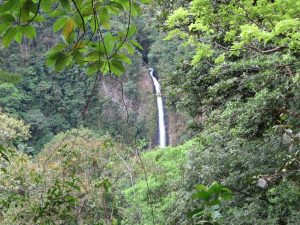By Greg S. Kowalski
Sustainabiltiy Studies student

One of the things that I have learned while studying up on, reading about, and visiting Costa Rica is how much a part of life sustainability is to every person there. Much of this credit goes to the Costa Rican government for having the foresight to see what an amazing country they have along with their unique location as a link between North and South America. This location allows them to harbor an abundance of plant and animal species native to both and some that are unique to Costa Rica itself. While visiting I had the opportunity to take a nocturnal hike through the cloud forest of Monteverde, hike to the base of LaFortuna waterfall near the base of the Arenal volcano, and kayak off the coast of a beach in Samara to an island in the Pacific in order to view some of their amazing plants and animals. The people who guided us taught us as we went and were very careful to point out rules in regards to what we could or could not do in regards to how they were keeping these places as natural and as sustainable as possible. The New Key to Costa Rica has some great information about the many parks and reserves and recommends some that are truly trying to remain sustainable. Another good source for all things Costa Rica is The Tico Times, an English language newspaper.

One of the other things that I observed while visiting there was how everyday ordinary people work to conserve resources, recycle, and sustain their country. To me, much of this was evident by just walking down the streets, or observing things at the eco-lodges where we stayed.

The lodges had recycling areas in prominent view, they had notes posted in the rooms asking to conserve water by not putting towels out every day for laundry, and also reminders to please turn out the lights in your room before leaving it.
While I stayed with a family in Nicoya I observed many of these same habits, whether it was due to the cost of utilities or the thought of conservation, many of the people I saw and houses I walked by were doing the same thing. They all hung laundry out to dry, although it is hot there which makes this easier to do, they used little water in their yards or gardens, and many had landscaping that survived without water, and just about every home I passed after dark had the lights turned off, even though people were up and out on their porches. Something else that really caught my eye or didn’t was the fact that businesses didn’t have all kinds of big flashy signs everywhere you looked, like you would see here. In fact it seemed to me when we walked down to town at night that many of them closed when it got dark, leaving many places dark for the evening, even the restaurants and bars that were open did not have all the neon signs beckoning you in. It seems that maybe we could learn a little here on how to conserve some electricity, reduce our carbon emissions, and be more sustainable if we just follow their examples.
Leave a Reply